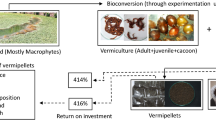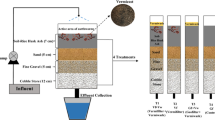Abstract
The study emphasized in understanding the dynamics of vermicomposting in conventional vermi-bed and smart vermicomposting bin using Dal Lake aquatic weed as substrate with turning frequency of 10 days and 20 days and 20, 40 and 60 days degradation period. In vermi-bed method, the materials were turned manually and a spiral mixer was used in smart vermicomposting bin. The results showed that pH, organic carbon and C:N ratio dwindled by 3.28%, 16.36% and 5.57% and there was an increase in EC by 22.39%, N 14.03%, P 37.78% and K 5.85% with 10 days turning frequency in vermi-bed vermicomposting system. In 20 days turning frequency, the values were 3.02, 22.58, 13.96, 42.86, 6.92 and 11.81%, respectively. When the Dal Lake aquatic weed was degraded in smart vermicomposting bin, it was observed that pH, organic carbon and C:N ratio shrunk by 5.63%, 14.94% and 24.88% with an increase in 11.23% N, 26% P, 10.4% K in 10 days turning frequency and 60 days degradation period. In 20 days turning interval, the values recorded were 6.23, 14.29, 24.56, 10.99, 20 and 16.77%, respectively. The cost of preparation of 1 kg of vermicompost was 20 and 13 Indian Rupees in vermi-bed and smart vermicomposting bin. The benefit cost ratio of smart vermicomposting bin was higher (1.78) than vermi-bed process in the second year. The study can help to shift from conventional to smart vermicomposting system to automate the system, reduce the dependence on manual labour and achieve the dream of organic agriculture.
Graphical Abstract










Similar content being viewed by others
Data Availability
Enquiries about data availability should be directed to the authors.
References
Muzamil, M., Rasool, S., Masoodi, H.M.: Insitu and exsitu agricultural waste management system. In: Agricultural waste-new insights. IntechOpen, London (2022)
Devi, C., Khwairakpam, M.: Weed biomass: bioconversion through composting followed by vermicomposting to optimize time required. Bioresour. Technol. Rep. 21, 101326 (2023). https://doi.org/10.1016/j.biteb.2022.101326
Kumar, A., Muzamil, M., Dixit, J.: Smart vermicomposting bin for rapid transformation of Dal Lake aquatic weed into fortified vermicompost. Int. J. Recycl. Waste Agric. 12(2), 221–233 (2023). https://doi.org/10.30486/ijrowa.2022.1955835.1445
Najar, I.A., Khan, A.B.: Vermicomposting of invasive species Azolla pinnata with Eisenia foetida. The Bioscan. Int. Q. J. Life Sci. 5(2), 239–241 (2010)
Kumar, S.: Aquatic weeds problems and management in India. Indian J. Weed Sci. 43(3–4), 118–138 (2011)
Tchobanoglous, G., Burton, F.L.: Wastewater engineering-treatment, disposal and reuse, p. 1334. Tata MCGraw Hill, New Delhi (1999)
Najar, I.A.: Studies on earthworm communities of Kashmir valley, their application in management of fresh water weeds (macrophytes) and use of vermicompost in horticulture. Pondicherry Central University, Pondicherry (2011)
Lim, S.L., Lee, L.H., Wu, T.Y.: Sustainability of using composting and vermicomposting technologies for organic solid waste biotransformation: recent overview, greenhouse gases emissions and economic analysis. J. Clean Prod. 111, 262–278 (2016). https://doi.org/10.1016/j.jclepro.2015.08.083
Waleed, S.A.: Cow manure composting by microbial treatment for using as potting material: an overview. Pak. J. Biol. Sci. 19, 1–10 (2016)
Sharma, A., Ganguly, R., Gupta, A.K.: Characterization and energy generation potential of municipal solid waste from nonengineered landfill sites in Himachal Pradesh, India. J. Hazard. Toxic. Radioact. Waste 23(4), 04019008 (2019)
Wong, S.H., Griffiths, D.A.: Vermicomposting in the management of pig-waste in Hong Kong. World J. Microbiol. Biotechnol. 7, 593–595 (1991)
Gajalakshmi, S., Ramasamy, E.V., Abbasi, S.A.: Potential of two epigeic and two anecic earthworm species in vermicomposting of water hyacinth. Bioresour. Technol. 76, 177–181 (2001)
Munnoli, P.M., Da-Silva, J.A.T., Saroj, B.: Dynamics of the soil-earthworm-plant relationship: a review. Dyn. Soil Dyn. Plant 4(1), 1–21 (2010)
Yingkai, L., Yang, X., Gao, W., Qiu, J., Yinsheng, L.: Comparative study of vermicomposting of garden waste and cow dung using Eisenia fetida. Environ. Sci. Pollut. Res. 27, 9646–9657 (2020). https://doi.org/10.1007/s11356-020-07667-x
Lim, S.L., Wu, T.Y., Lim, P.N., Shak, K.P.Y.: The use of vermicompost in organic farming: overview, effects on soil and economics. J. Sci. Food Agric. 95, 1143–1156 (2015). https://doi.org/10.1002/jsfa.6849
Chauhan, H.K., Singh, K.: Effect of tertiary combinations of animal dung with agrowastes on the growth and development of earthworm Eisenia fetida during organic waste management. Int. J. Recycl. Org. Agric. 2, 11 (2013)
Gong, X., Suyan, L., Chang, S.X., Wu, Q., Cai, L., Sun, X.: Alkyl polyglycoside and earthworm (Eisenia fetida) enhance biodegradation of green waste and its use for growing vegetables. Ecotoxicol. Environ. Saf. 167, 459–466 (2019). https://doi.org/10.1016/j.ecoenv.2018.10.063
Muzamil, M., Mani, I., Shukla, L., Lande, S.: Efficiency of pusa compost inoculant along with windrow turner for rapid degradation of paddy straw. J. Pure Appl. Microbiol. 8(1), 569–576 (2014)
Hande, A.S., Padole, V.: Design and fabrication of portable organic waste chopping machine to obtain compost. Int. J. Innov. Res. Sci. Tech. 2(3), 1–8 (2015). https://doi.org/10.1007/s10669-006-8641-z
Muzamil, M., Rasool, S., Masoodi, H.M., Magray, M., Bangroo, S., Malik, A., Banday, S.: Mechanization in agricultural production from horizontal and vertical perspective. In: Kuden, A. (ed.) Urban horticulture-sustainable gardening in cities. Intech open, London (2023)
Ismail, S.A.: The earthworm book, p. 101. India Press, Mapusa (2005)
Devi, C., Khwairakpam, M.: Bioconversion of Lantana camara by vermicomposting with two different earthworm species in monoculture. Bioresour. Technol. 296, 122308 (2020). https://doi.org/10.1016/j.biortech.2019.122308
Muzamil, M., Mani, I., Kumar, A., Shukla, L.: An engineering intervention to prevent paddy straw burning through in situ microbial degradation. J. Inst. Eng. India Ser. A 102, 11–17 (2021). https://doi.org/10.1007/s40030-020-00490-0
Jackson, M.L.: Soil chemical analysis, pp. 123–134. Prentice Hall of India Pvt. Ltd, New Delhi (1973)
Subbiah, B.V., Asija, G.L.: A rapid procedure for the estimation of available nitrogen in soil. Curr. Sci. 25, 226–259 (1956)
Olsen, S.R., Cole, C.V., Watanabe, F.S., Dean, L.A.: Estimation of available phosphorus in soils by extraction with sodium bicarbonate, pp. 1–19. U. S. Government Printing Office, Washington (1954)
Jackson, M.L.: Soil chemical analysis, p. 498. Prentice Hall of India Pvt. Ltd, New Delhi (1967)
Walkley, A., Black, I.A.: An examination of Degtjareff method for determining soil organic matter and a proposed modification of the chromic acid titration method. Soil Sci. 37, 29–38 (1934)
Zhou, B., Chen, Y., Zhang, C., Li, J., Tang, H., Liu, J., Dai, J., Tang, J.: Earthworm biomass and population structure are negatively associated with changes in organic residue nitrogen concentration during vermicomposting. Pedosphere 31(3), 433–439 (2021)
Muzamil, M., Wani, J., Mustafa, A., Mohiuddin, M., Mir, A., Faisal, S., Nirbhavane, S.: A low cost divergent type apple grader for Kashmiri apples. Int. J. Curr. Microbiol. Appl. Sci. 7, 3561–3569 (2018)
Sridevi, S., Prabu, M., Tamilselvi, N.G.: Bioconversion of water hyacinth into enriched vermicompost and its effect on growth and yield of peanut. Int. J. Curr. Microbiol. Appl. Sci. 5(9), 675–681 (2016)
Fu, X., Huang, K., Chen, X., Li, F., Cui, G.: Feasibility of vermistabilization for fresh pelletized dewatered sludge with earthworms Bimastus Parvus. Bioresour. Technol. 175, 646–650 (2015). https://doi.org/10.1016/j.biortech.2014.11.007
Sharma, K., Garg, V.K.: Comparative analysis of vermicompost quality produced from rice straw and paper waste employing earthworm Eisenia fetida (Sav). Bioresour. Technol. 250, 708–715 (2018). https://doi.org/10.1016/j.biortech.2017.11.101
Huang, G.F.: Effect of C/N on composting of pig manure with sawdust. Waste Manag. 24(8), 805–813 (2004)
Anakaram, S.R., Mushan, L.C., Rao, K.R.: Management of water hyacinth (Eichhornia crassipes), an aquatic weed waste, by vermicomposting technology. Int. J. Environ. Technol. Manag. 15(3–6), 195–207 (2012)
Viveka, S., Grace, L.B.: Utilization of weeds as substrates for vermifertilizer. Dyn. Soil Dyn. Plant 5(1), 83–86 (2011)
Lazcano, C., Gómez-Brandón, M., Domínguez, J.: Comparison of the effectiveness of composting and vermicomposting for the biological stabilization of cattle manure. Chemosphere 72, 1013–1019 (2008). https://doi.org/10.1016/j.chemosphere.2008.04.016
Liu, J., Lu, Z., Yang, J., Xing, M., Yu, F., Guo, M.: Effect of earthworms on the performance and microbial communities of excess sludge treatment process in vermifilter. Bioresour. Technol. 117, 214–221 (2012). https://doi.org/10.1016/j.biortech.2012.04.096
Sehar, T., Zargar, M.Y., Baba, Z.A.: Physical properties of vermicompost produced by locally isolated earthworms from temperate Kashmir region. Int. J. Curr. Res. 7(12), 23982–23987 (2015)
Ghosh, M., Chattopadhyay, G.N., Baral, K.: Transformation of phosphorous during vermicomposting. Bioresour. Technol. 69, 149–154 (1999)
Padmavathiamma, P.K., Li, L.Y., Kumari, U.R.: An experimental study of vermibiowaste composting for agricultural soil improvement. Bioresour. Technol. 99(6), 1672–1681 (2008)
Swarnam, T.P., Velmurugan, A., Pandey, S.K., Dam, R.S.: Enhancing nutrient recovery and compost maturity of coconut husk by vermicomposting technology. Bioresour. Technol. 207, 76–84 (2016). https://doi.org/10.1016/j.biortech.2016.01.046
Yuvaraj, A., Karmegamb, N., Thangaraja, R.: Vermistabilization of paper mill sludge by an epigeic earthworm Perionyx excavatus: Mitigation strategies for sustainable environmental management. Ecol. Eng. 120, 187–197 (2018)
Ansari, A.A., Jaikishun, S.: Vermicomposting of sugarcane bagasse and rice straw and its impact on the cultivation of Phaseolus vulgaris L. in Guyana, South America. J. Agric. Technol. 7(2), 225–234 (2011)
Sharma, A., Ganguly, R., Gupta, A.K.: Spectral characterization and quality assessment of organic compost for agricultural purposes. Int. J. Recycl. Org. Waste Agric. 8, 197–213 (2018). https://doi.org/10.1007/s40093-018-0233-7
Elvira, C., Sampedro, L., Benitez, E., Nogales, R.: Vermicomposting of sludges from paper mill and dairy industries with Eisenia Endrei: a pilot scale study. Bioresour. Technol. 63, 205–211 (1998)
Garg, V.K., Kaushik, P.: Vermistablization of textile mill sludge spiked with poultry droppings by epigecic earthworm Eisenia fetida. Bioresour. Technol. 96, 1063–1071 (2005)
Nath, G., Singh, K., Singh, D.K.: Chemical analysis of vermicomposts/vermiwash of different combinations of animal, agro and kitchen wastes. Aust. J. Basic Appl. Sci. 3(4), 3672–3676 (2009)
Suthar, S.: Bioconversion of post-harvest crop residues and cattle shed manure into value-added products using earthworms Eudrilus eugeniae. Ecol. Eng. 32, 206–214 (2007)
Vig, A.P., Singh, J., Wani, S.H., Dhaliwal, S.: Vermicomposting of tannery sludge mixed with cattle dung into valuable manure using earthworm Eisenia fetida (Savigny). Bioresour. Technol. 102, 7941–7945 (2011). https://doi.org/10.1016/j.biortech.2011.05.056
Acknowledgements
The authors sincerely acknowledge the help rendered by the staff members of college of agricultural engineering and technology, SKUAST-K that led to the completion of this research activity.
Funding
The research was a part of academic programme. The authors declare that no funds, grant or other support were received during the preparation of this manuscript or study.
Author information
Authors and Affiliations
Contributions
All the authors contributed equally in the experimental design, analysis and preparation of manuscript.
Corresponding author
Ethics declarations
Competing interests
The authors have no financial or non-financial interests to disclose.
Additional information
Publisher’s Note
Springer Nature remains neutral with regard to jurisdictional claims in published maps and institutional affiliations.
Rights and permissions
Springer Nature or its licensor (e.g. a society or other partner) holds exclusive rights to this article under a publishing agreement with the author(s) or other rightsholder(s); author self-archiving of the accepted manuscript version of this article is solely governed by the terms of such publishing agreement and applicable law.
About this article
Cite this article
Kumar, A., Muzamil, M., Rashid, S. et al. Qualitative Evaluation and Economic Assessment of Dal-Lake Aquatic Weed Vermicompost Prepared in Conventional Vermi Bed and Smart Vermicomposting Bin. Waste Biomass Valor 15, 3187–3197 (2024). https://doi.org/10.1007/s12649-023-02335-w
Received:
Accepted:
Published:
Issue Date:
DOI: https://doi.org/10.1007/s12649-023-02335-w




